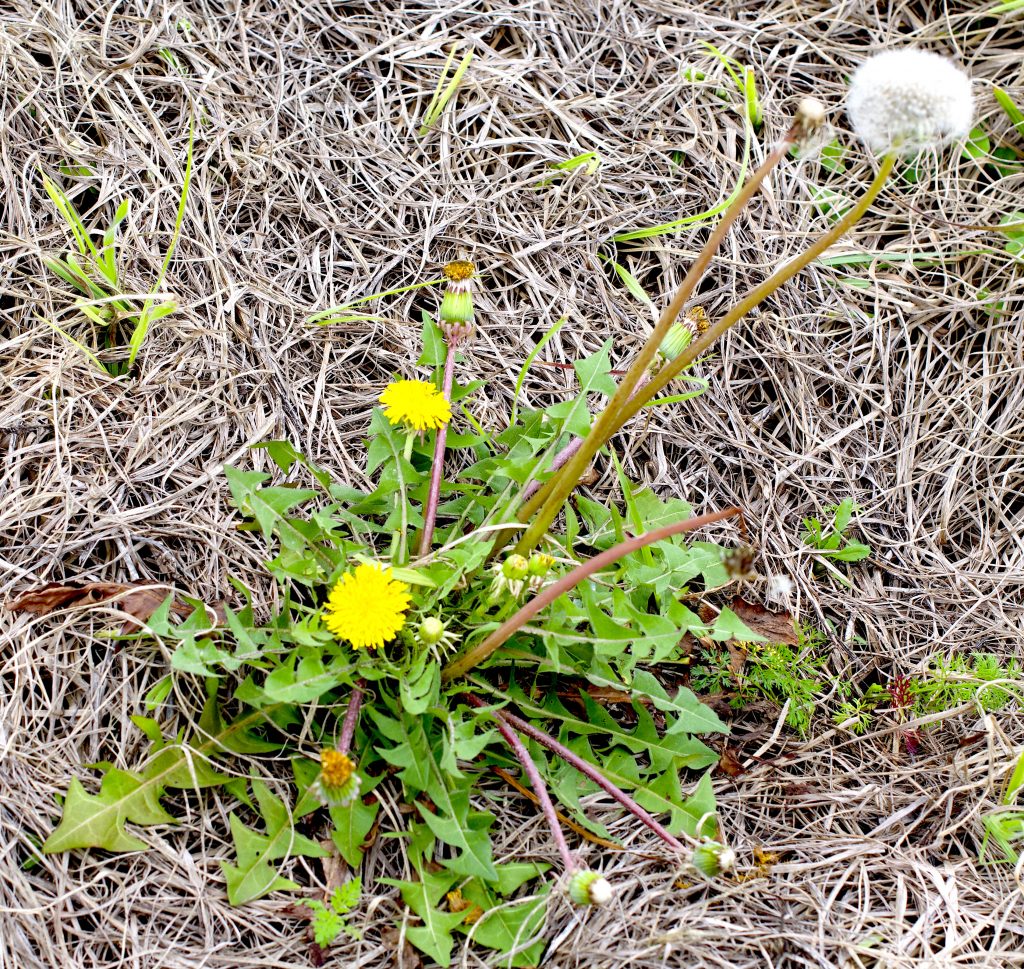
Dandelions are sporadic in Florida. Photo by Green Deane
Dandelion blossoms, ten pounds of sugar, and two cakes of bread yeast became my first batch of wine. I was in grammar school at the time but an old hand by then having already made two five-gallon batches of beer out of cooking malt. The wine came out far better than the beer which was made in a five-gallon crock in the basement. (I had to use an oil lamp under it to keep it warm enough to ferment in the winter.) Back then all soda bottles took a cap and we had a capper for making homemade root beer. Thus most of the beer and later the wine went into 16-ounce used Coca-Cola bottles. I can remember one of our neighbors — a Mr. Gowen — getting quite drunk on that Dandelion wine one night. To an 8th grader that was success.
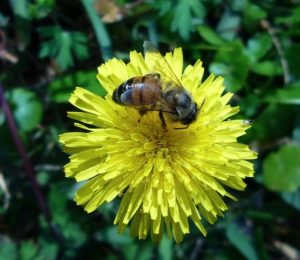
Photo by Green Deane
The Dandelions I used were huge with blossoms nearly two inches across. They grew in large colonies so it took very little time to collected several pounds of them (and one had the greens for supper.) Unfortunately that is not possible here in warm Florida. Dandelions hate hot weather which is why this abundant northern blossom is seen sporadically during our winter, and then often an anemic version of the real thing. Look around oaks in our cooler months. Dandelions are, of course, not only prime food but medicine as well. If you want to know more about them and a wine recipe you can go here.
Florida’s beaches this time of year start to collect dead seaweed. It is nearly all one species, Sargassum; edible but not the tastiest of sea vegetables. It is true that nearly all seaweeds are edible if harvested from clean water. When I lived in Japan an annual environmental demonstration was to develop photographic film from unaltered water taken from Tokyo Bay. Instead of taking a few minutes, the developing took several hours but the point was made: The bay water was polluted. Generally said there are only two non-edible seaweeds in North America.
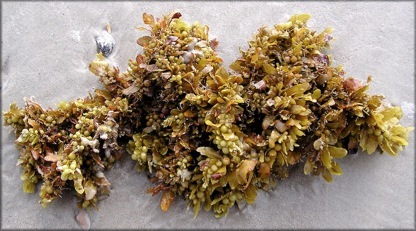
Sargassum: Edible but not the best of tastes.
The first is Desmarestia ligulata. It is laced with sulfuric acid but is used to make pickles. You can find it along the northwest coast of the United States. You’ll know it when you find it because it will burn your mouth. The other in North America (and Central America) is Cyanobacteria which is found in the Caribbean and linked to ciguarera poisoning. It’s not really a seaweed but is a blue-green algae found in the warmer waters. It is why one should never eat older barracuda. I should add never eat blue-green algae from fresh water either nor fish from a fresh water pond with a lot of blue-green algae. They are not on the menu. As for other parts of the world, there might be some toxic red seaweeds in the South Seas. Since most seaweed is edible, and nutritious, why isn’t it consumed more often? Taste and texture. I’ve collected Sargassum here in Florida and prepared it many ways. Semi-drying and frying isn’t too bad but Bladderwrack is better, Sea Lettuce better still. The latter makes very nice salads. Not surprisingly most land animals including birds don’t like seaweed. However, it does make good mulch and fertilizer. So while one may not use it directly in the diet it can still help sustain you with uses in the garden. During Victorian times it was highly used in English agriculture. Here are some of my articles on seaweed: Bladderwrack, Caulpera, Codium, Gracilaria, Sargassum, Sea Lettuce, and Tape Seagrass.

Foraging classes are held rain, shine, hot or cold. Photo by Nermina Krenata
Foraging Classes: I’m staying around the middle part of the state this weekend with a class in East Orlando and west of Deland. There’s a good amount of walking with the Sunday class.
Saturday November 9th Blanchard Park, 10501 Jay Blanchard Trail, Orlando, FL 32817. 9 a.m. to noon. Meet next to the tennis courts by the YMCA building.
Sunday, November 10th, Lake Woodruff National Wildlife Refuge, 2045 Mud Lake Road, DeLeon Springs, FL. 9 a.m. to noon. This class is rare because the federal property can be closed without notice. Meet at the first parking lot west of the railroad tracks.
Saturday, November 16th, Florida State College, south campus, 11901 Beach Blvd., Jacksonville, 32246. 9 a.m. to noon. We will meet at building “D” next to the administration parking lot.
Sunday, November 17th, Eagle Park Lake, 1800 Keene Road, Largo, FL 33771. 9 a.m. to noon. Meet at the pavilion by the dog park.
Saturday, November 23rd, Dreher Park, 1200 Southern Blvd., West Palm Beach, 33405. 9 a.m. to noon. Meet in the parking lot just north of the science center.
Sunday, November 24th, Bayshore Live Oak Park, Bayshore Drive. Port Charlotte. 9 a.m. to noon. Meet at the parking lot at the intersection of Bayshore Road and Ganyard Street. 9 a.m. to noon.
Saturday November 30th, Boulware Springs Park, 3420 SE 15th St., Gainesville, FL 32641. 9 a.m. to noon. Meet at the picnic tables next to the pump house.
For more information about classes, to sign up or pre-pay go here.
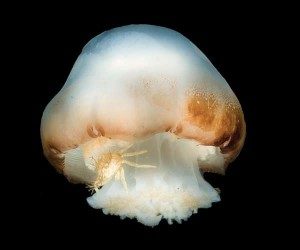
Many Jellyfish are edible.
While on the topic of the beach — I will be there this weekend for Greek festival, a birthday, and Veterans Day — many jellyfish are edible, including some that are found in local waters. I had a friend from Taiwan who never ordered from the menu at Chinese restaurants. It was always off-the-menu and then after much discussion with the waiter and sometimes the chef. One of those chats produced a dish of jellyfish. I was hooked. It was very tasty and jellyfish can be caught while casting for other fish. (I like castnetting and am a castnet junkie.) While a substantial food I’m not sure jellyfish would qualify as a staple because catching them by hand is by chance (which does increase however when in season.) They are also mostly water and need to be dessicated immediately, not a small process. It all depends on how hungry you are and how many of them you have. You should get them live out of the water, not dead on the beach. To read about jellyfish go here.
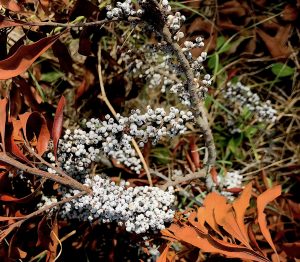
Southern Wax Myrtle berries. Photo by Green Deane
Just because you can do something doesn’t mean you should. Can you make a bayberry candle? Absolutely. Should you? If you have to, yes. If not you might want to reconsider. Southern Wax Myrtle berries are small. They have a little wax on them and why the species name is cerifera — wax producing. But it takes many gallons and a lot of hot work to get enough bayberry wax to mix with tallow (75/25) to make the famous smokeless candle that keeps away insects. No doubt hundreds of years ago it was worth it when folks had tallow from their own cattle, a lot of Bayberries and mosquitoes. Not so much today. But, you can use the dried berries as a spice and the leaves like bay leaves or to make a tea. To read more about the Southern Wax Myrtle go here.
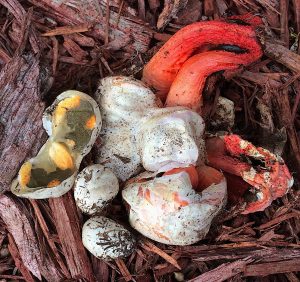
Stinkhorn Mushroom. Photo by Green Deane
There is a strange mushroom you can see this time of year that nearly no one eats, the Column Stinkhorn. It smells like a dead animal, not exactly appetizing. The edibility of the Column Stinkhorn is also debatable. Most list it as not edible and there are reports of sickness in humans eating mature specimens. However, at least one noted expert says when in the egg stage they are mild and edible such as on the left side of the picture. It takes me years of studying a mushroom before I eat it. I think this one needs more study. Their fetid aroma attracts flies which then spread the spores around. Some plants also do that. Pawpaw comes to mind.
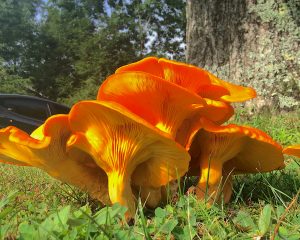
Jack O’Lanterns. Photo by Green Deane
One attractive mushroom you should avoid are Jack O’Lanterns. They’re toxic and glow in the dark! A least one expert says “Jack O’ Lanterns” don’t glow in the dark but I took some home and they most certainly do. That is one of those irritation with plants. A recognized expert says one thing but your personal experience says something totally different. “Jacks” as they are called won’t kill you but they will make you very ill. I know someone who found that out personally… No, it was not me. I prefer to be non-sick. To that end I started and moderate five mushroom pages on Facebook: Southeastern US Mushroom Identification, Florida Mushroom Identification Forum, Edible Mushroom: Florida, Edible Wild Mushrooms and the Orlando Mushroom Group. They have several thousand members.
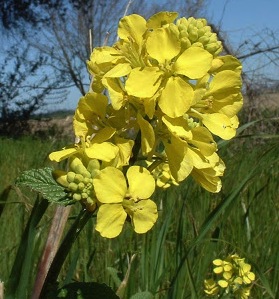
Wild Mustard and Wild Radish are used the same way.
The C.R.A.B.S.* took to the trails and rode 30-plus miles through Seminole County today. One of the nice things about riding a recumbent trike is you are down where the plants are and your viewing angle forward (as mentioned on my facebook page The Green Deane Machine.) While pedaling along I spied my first Wild Radish of the season. Wild Radish and Wild Mustards look very similar and are used the same way. There are many ways to tell them apart but on a glance one identifier of the radish is that it grows in a serpentine manner whereas mustards tend to grow straight up. I usually start to find tasty Wild Radishes and Wild Mustards in December so perhaps the season is a little early this year. To read more about Wild Radish, go here. Wild Mustards click here. *Crusty Retired All recumBent Society.
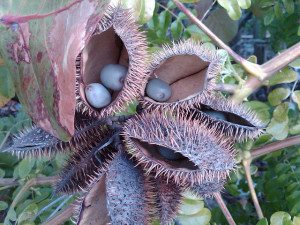 Want to identify a plant? Perhaps you’re looking for a foraging reference? You might have a UFO, an Unidentified Flowering Object, you want identified. On the Green Deane Forum we — including Green Deane and others from around the world — chat about foraging all year. And it’s not just about warm-weather plants or just North American flora. Many nations share common weeds so there’s a lot to talk about, such as the one to the left. There’s also more than weeds. The reference section has information for foraging around the world. There are also articles on food preservation, and forgotten skills from making bows to fermenting food. Recent topics include: California Wild Mushroom Parties, A Good Reason To Eat Wild Garlic, Black Walnuts and Amaranth, Sea Salt and Plastic, Wild Mustard? Heavy Metals. Oriental Persimmons. What is it? Pine Cough Drops and Needles, Skullcap, Malodorous Plant? Another NJ Tree, Maypop? Roadside Plant, Unknown in Sudan, Please Help Identify, and Preserving Prickly Pear Bounty. You can join the forum by clicking on the button on the upper right hand side of this page.
Want to identify a plant? Perhaps you’re looking for a foraging reference? You might have a UFO, an Unidentified Flowering Object, you want identified. On the Green Deane Forum we — including Green Deane and others from around the world — chat about foraging all year. And it’s not just about warm-weather plants or just North American flora. Many nations share common weeds so there’s a lot to talk about, such as the one to the left. There’s also more than weeds. The reference section has information for foraging around the world. There are also articles on food preservation, and forgotten skills from making bows to fermenting food. Recent topics include: California Wild Mushroom Parties, A Good Reason To Eat Wild Garlic, Black Walnuts and Amaranth, Sea Salt and Plastic, Wild Mustard? Heavy Metals. Oriental Persimmons. What is it? Pine Cough Drops and Needles, Skullcap, Malodorous Plant? Another NJ Tree, Maypop? Roadside Plant, Unknown in Sudan, Please Help Identify, and Preserving Prickly Pear Bounty. You can join the forum by clicking on the button on the upper right hand side of this page.
 Donations to upgrade EatTheWeeds.com have gone well. Thank you to all who have contributed to either via the Go Fund Me link, the PayPal donation link or by writing to Green Deane POB 941793 Maitland FL, 32794. There are many needs left such as expanding the foraging teacher page and the page on monotypic edibles. There’s always something and such things get more complex and expensive every year.
Donations to upgrade EatTheWeeds.com have gone well. Thank you to all who have contributed to either via the Go Fund Me link, the PayPal donation link or by writing to Green Deane POB 941793 Maitland FL, 32794. There are many needs left such as expanding the foraging teacher page and the page on monotypic edibles. There’s always something and such things get more complex and expensive every year.
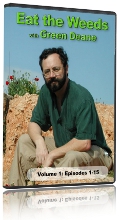 All of Green Deane’s videos are available for free on You Tube. They do have ads on them so every time you watch a Green Deane video I get a quarter of one cent. Four views, one cent. Not exactly a large money-maker but it helps pays for the newsletter. If you want to see the videos without ads and some in slightly better quality you can order the DVD set. It is nine DVDs with 15 videos on each. Many people want their own copy of the videos or they have a slow service and its easier to order then to watch them on-line. They make a good Christmas or birthday gift. Individual videos can also be ordered. You can order them by clicking on the button on the top right of this page or you can go here.
All of Green Deane’s videos are available for free on You Tube. They do have ads on them so every time you watch a Green Deane video I get a quarter of one cent. Four views, one cent. Not exactly a large money-maker but it helps pays for the newsletter. If you want to see the videos without ads and some in slightly better quality you can order the DVD set. It is nine DVDs with 15 videos on each. Many people want their own copy of the videos or they have a slow service and its easier to order then to watch them on-line. They make a good Christmas or birthday gift. Individual videos can also be ordered. You can order them by clicking on the button on the top right of this page or you can go here.
This is weekly newsletter 379. If you want to subscribe to this free newsletter you can find the sign-up form in the menu at the top of the page.
To donate to the Green Deane Newsletter click here.

